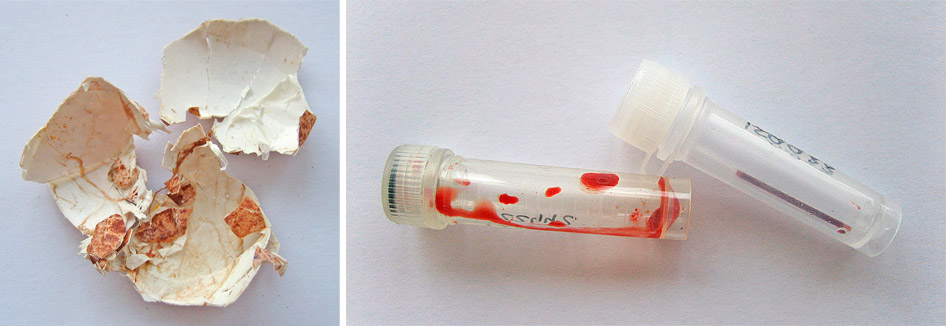Parentage analysis
The hereditary information of every living organism, also in pigeons, is carried by its DNA. The DNA contains a genetic code that uniquely defines an individual. Two individuals can only possess identical genetic codes if they are identical twins. The genetic code is fixed throughout a pigeon’s lifetime. By analysing the DNA, the genetic code of a pigeon (the so-called genotype) can be determined. This genotype can be used to identify a pigeon, but can also be used in a parentage analysis.
- Parentage analysis: The DNA-genotype of an individual is derived from the DNA-genotype of both parents; offspring inherit 50% of their genetic code from their mother and 50% from their father. Parentage analysis uses this information to determine an individual’s origin. Whether an individual is indeed an offspring of its suspected parents can be determined by comparing their DNA-genotypes.
- Identification: The DNA-genotype of an individual may be used a “passport” that can later be used to identify the individual. This passport may for instance identify a bird that has been stolen.
Bird sexing
In many pigeon species, external sex characteristics are lacking and the sex of an individual pigeon cannot be determined from its appearance. To determine the sex of an individual pigeon, DNA-analysis performed on plucked feathers is a fast and reliable method. A sensitive method is used to detect a small part of specific DNA on the sex chromosomes, which is different between male (ZZ) and female (ZW) pigeons.
Detection of young pigeon disease syndrome
Young pigeon disease syndrome is a serious illness that may cause the death of young pigeons within a few days after showing the first symptoms. Common symptoms are general symptoms of illness such as fluffed feathers and a low reactivity, combined with (green) diarrhoea and vomiting. Young pigeon disease syndrome is caused by one or a combination of three different viruses: pigeon herpesvirus, pigeon circovirus and pigeon adenovirus. Secondary infections with bacteria (i.e. E. coli) and fungi may cause additional problems. The viruses can be transmitted through the feather dust of adult pigeons carrying them without showing symptoms. Gendika tests for the presence of the three viruses.
Sample material
To detect the presence of all three viruses, both a blood sample and a swab of the cloaca of the bird are needed. If the test for only one of the viruses is requested, both a swab and a blood sample are needed as well. Furthermore, a sample of liver tissue can be used for post-mortal detection of the viruses.
Gendika advices her customers to let a veterinarian collect the samples and send them to us. Gendika provides vials for the collection of blood free of charge. Please ensure that swab- and/or blood samples are accompanied by a signed order form. The order form can be requested by calling: 0031 (0)598-619343, by emailing us at info@gendika.com, or can be downloaded from our website.
Results of disease analyses
- Blood- and swab samples will be processed on the day of their arrival at Gendika. After approximately three business days, the analysis results will be available.
- After the analysis has been completed you will receive the results by mail. Included are a report and a plasticized certificate that gives an overview of the viruses detected, as well as the invoice. If you filled in your email address, you will also receive the results by email.
- In case the analysis results indicate that your birds are infected, we recommend that you contact your veterinarian. Your veterinarian can inform you about the appropriate measures to prevent further infection and treatment of the infected bird(s).




